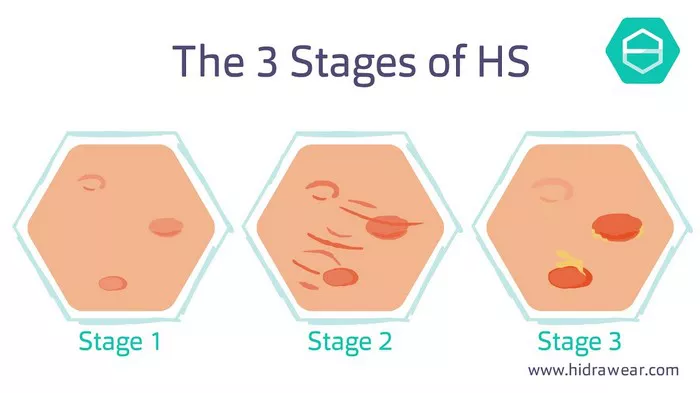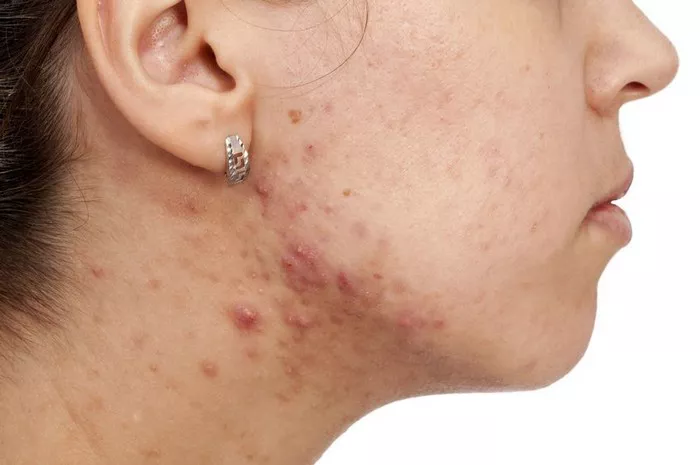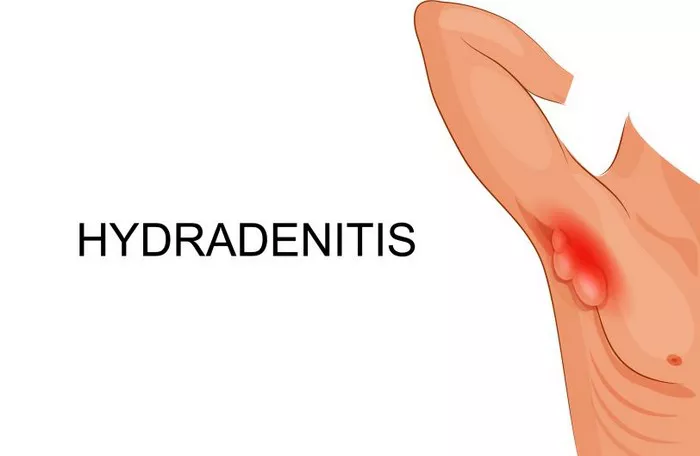Hidradenitis suppurativa (HS) is a chronic skin condition that can significantly impact a person’s quality of life. It often begins with painful lumps and can progress to more severe symptoms, including abscesses and scarring. Understanding these symptoms is crucial for early detection, treatment, and management of the condition.
1. Painful Bumps
Characteristics of the Bumps
The initial symptom of HS is the development of painful bumps or nodules under the skin. These bumps are often:
Firm and tender: The pain can range from mild to severe, making movement uncomfortable.
Located in specific areas: Common sites include:
- Armpits
- Groin
- Buttocks
- Under breasts
- Inner thighs
Why They Occur
These bumps develop due to inflammation of the hair follicles, often triggered by friction, heat, and moisture in skin folds.
2. Abscess Formation
What Is an Abscess?
An abscess is a localized collection of pus that forms when the body fights an infection. In HS, abscesses can develop from the painful bumps.
Symptoms of Abscesses:
- Redness: The skin around the bump becomes inflamed and red.
- Warmth: The affected area may feel warm to the touch.
- Swelling: The area can swell significantly, making it appear larger.
Treatment Options
Abscesses may require drainage. A healthcare professional can perform this procedure, relieving pressure and pain.
3. Drainage of Pus
Chronic Drainage
After an abscess bursts, it may lead to chronic drainage. This can be distressing for individuals and may have the following characteristics:
Color and Consistency: The pus can be yellow, brownish, or even blood-stained and thick.
Odor: The drainage may have a foul smell, which can cause embarrassment.
Frequency: Continuous drainage can make personal hygiene challenging and may require frequent dressing changes.
4. Scarring and Skin Changes
Long-Term Effects on Skin
As HS progresses, the skin can undergo significant changes:
Thickened Skin: Areas affected may become thicker and less flexible.
Hyperpigmentation: Dark patches can develop, particularly after flare-ups.
Scarring: Scars may form as bumps heal. These can be extensive and may affect appearance and skin function.
Caring for Scars
Preventing and managing scars involves proper wound care and possibly treatments like silicone gels or laser therapy.
5. Fistula Formation
Understanding Fistulas
Fistulas are abnormal connections that can develop between skin surfaces. They may arise from repeated abscess formation.
Symptoms of Fistulas:
- Small Openings: You may notice tiny openings on the skin that can drain fluid.
- Continuous Drainage: Fistulas can lead to persistent drainage, complicating the management of HS.
- Pain or Discomfort: Fistulas can cause additional pain and discomfort in the affected area.
Treatment for Fistulas
Medical intervention may be necessary, often involving surgical options to remove the affected tissue and close the fistula.
6. Recurring Symptoms
Flare-Up Patterns
HS is known for its recurring nature. Symptoms can appear in cycles, with flare-ups and periods of remission. This cyclical pattern can be frustrating and unpredictable.
Identifying Triggers: Understanding personal triggers (such as heat, stress, or friction) can help manage flare-ups.
7. Itching and Irritation
Managing Itchiness
Itching can accompany HS, especially in areas with active lesions. This can lead to scratching, which may worsen the condition.
Symptoms of Itching:
- Burning Sensation: Itching may be accompanied by a burning feeling.
- Inflammation: Scratching can increase inflammation, leading to more severe symptoms.
Prevention Strategies
Using soothing creams or topical medications may help alleviate itching and reduce the urge to scratch.
8. Changes in Hair Follicles
Impact on Hair Growth
HS directly affects hair follicles, leading to various changes:
Hair Loss: You may notice thinning or loss of hair in areas affected by HS.
Ingrown Hairs: The condition can cause ingrown hairs, which can be painful and contribute to inflammation.
Pimples and Bumps: Some bumps may resemble acne or pimples but are related to the underlying condition.
9. Systemic Symptoms
When HS Affects Overall Health
In some cases, HS can lead to systemic symptoms that affect overall well-being. These symptoms may include:
Fatigue: Chronic pain and discomfort can lead to significant fatigue.
Fever: Flare-ups can sometimes be accompanied by mild fevers, indicating inflammation.
Weight Loss: Some individuals may experience unintended weight loss due to the chronic nature of the disease.
Consulting a Healthcare Provider
If systemic symptoms occur, it’s essential to discuss them with a healthcare provider, as they may indicate complications or secondary infections.
10. Emotional Impact
Mental Health Challenges
The physical symptoms of HS can have a profound emotional and psychological impact. Individuals may experience:
Embarrassment: Visible symptoms can lead to self-consciousness and avoidance of social situations.
Isolation: Chronic conditions can lead to feelings of isolation or being misunderstood by others.
Anxiety and Depression: The ongoing nature of HS may contribute to anxiety or depressive symptoms.
Seeking Support
It’s important to seek support from healthcare professionals, therapists, or support groups. Connecting with others who understand can provide comfort and coping strategies.
Conclusion
Recognizing the symptoms of hidradenitis suppurativa is vital for effective management and treatment. If you notice signs such as painful bumps, abscesses, chronic drainage, or skin changes, it’s essential to consult a healthcare professional. Early intervention can help reduce symptoms, manage flare-ups, and improve quality of life.
HS is a complex condition, but with the right knowledge and support, individuals can navigate its challenges more effectively. Understanding your body and advocating for your health is a critical step toward managing hidradenitis suppurativa successfully.
Related topics:
























